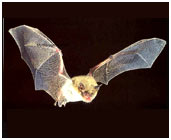Bats are found inhabiting almost all the countries of the world. To get acquainted with the mammal, check out the interesting facts and amazing information given here.
Facts About Bats
Bats are amongst the most feared, most hated and most misunderstood animals in the world. They can be divided into two main groups, the mega-chiroptera and the micro-chiroptera. The first group comprises of those bats that eat fruit, nectar, and pollen. They have a face that resembles that of a fox, to some an extent, and also have big eyes for finding food. The latter group, on the other hand, comprises of the bats that eat insects. They navigate and hunt through echolocation, a system based on high-pitched sounds that bounce off objects and come back to the bats. To know more about bats, check out the interesting facts and amazing information given below. 

Facts about Bats
Kingdom: Animalia
Phylum: Chordata
Class: Mammalia
Infraclass: Eutheria
Superorder: Laurasiatheria / Archonta (debated)
Order: Chiroptera
Suborder: Mega-chiroptera & Micro-chiroptera
Family: 18 families
Genus: 180 genera
Species: Around 1100
Wingspan: 16 cm to 2 m (depending upon the species)
Weight: 14 gm to 1.5 kg (depending upon the species)
Smallest Species: Bumblebee Bat of Thailand
Diet: Either fruit, nectar and pollen or insects, small mammals and fish
Natural Habitat: Throughout the world, except for extreme arctic and desert regions
Age: 30 years
Age of Maturity: 6 months to 2 years (depending upon the species)
Gestation Period: 1.5 to 9 months (depending upon the species)
Number of Offspring: One
Interesting & Amazing Information on Bats
- Bats are the only mammal that can actually fly and make up the second largest order of mammals in the world.
- A little brown bat (myotis) can eat up to 1000 mosquitoes in one hour.
- A mother bat can locate her pup (baby) out of millions in a roost, by tracking down its scent and sound.
- African heart-nosed bats can hear the footsteps of a beetle walking on sand, from a distance of more than six feet.
- Agricultural plants like bananas, bread-fruit, mangoes, cashews, dates and figs rely on bats for pollination and seed dispersal.
- Bats are extremely clean animals and groom themselves almost on a constant basis.
- Bats give birth to only one baby in a year, making them one of the slowest reproducing mammals on earth for their size.
- Bats seldom transmit disease to other animals or even humans.
- During winter hibernation, Red Bats can withstand body temperatures as low as 23 degrees.
- Frog eating bats differentiate between edible and poisonous frogs by listening to the mating calls of male frogs.
- Giant flying foxes, which are native to Indonesia, have a wingspan of nearly six feet.
- Many species of bats roost together in large groups, known as colonies.
- Most of the bats have very good eyesight. They also have excellent echolocation skills.
- Most of these bat species are so small that they would easily fit in the palm of your hand.
- Some of the bats migrate to warmer climates during the winter, while the others hibernate.
- Studies have indicated that the Old World fruit bats and flying foxes might have descended from early primates.
- The bumblebee bat of Thailand is the smallest mammal in the world.
- The droppings of bats in caves support whole ecosystems of unique organisms, including bacteria.
- Honduran white bat is completely white in color, with the exception of yellow nose and ears.
- The tiny woolly bats of West Africa live in the large webs of colonial spiders.
- Vampire bats are one of the few mammals who risk their own lives to share food with the less fortunate roost-mates.
- When hibernating, little brown bats can reduce their heart rate to 20 beats per min and even can stop breathing altogether, for 48 min at a stretch.


See also
More in 'Society'
More from iloveindia.com
- Home Remedies | Ayurveda | Vastu | Yoga | Feng Shui | Tattoos | Fitness | Garden | Nutrition | Parenting | Bikes | Cars | Baby Care | Indian Weddings | Festivals | Party ideas | Horoscope 2015 | Pets | Finance | Figures of Speech | Hotels in India : Delhi | Hyderabad | Chennai | Mumbai | Kolkata | Bangalore | Ahmedabad | Jaipur
- Contact Us Careers Disclaimer Privacy Policy Advertise With Us Lifestyle Sitemap Copyright iloveindia.com. All Rights Reserved.




